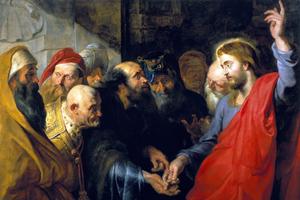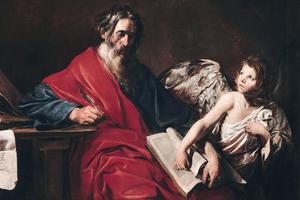Life, Death and Faith, and the Raising of the Daughter of Jairus
SCRIPTURES & ART: A meditation on the readings for the Thirteenth Sunday in Ordinary Time

As noted last week, Jesus’ miracles come in two varieties: those involving nature and those involving healing. Last week’s Gospel, about Jesus calming the storm at sea, exemplified the former. This week’s Gospel, about the healing of a woman with a hemorrhage and the raising of Jairus’ daughter, exemplifies the latter.
It’s not accidental that the healing of the woman and the raising of Jairus’ daughter are combined in the Gospel, because Christianity sees a correlation between sin, sickness, suffering and death. It’s not that Christianity draws a straight line between one and the other — as the Apostles did, for example, with the man born blind when they asked, “who sinned, Rabbi, the man or his parents?” (John 9:2). But it does recognize that if “the glory of God is man fully alive” (St. Irenaeus), then what impedes his life, what causes disintegration and decay is not God’s design but the falling away from it, i.e., sin. Jesus came “that [we] might have life and have it to the full” (John 10:10) — as is clear in today’s Gospel.
Like last week, Jesus called for his Apostles faith in the face of a storm outside their control. This week, Jesus repeats his call for faith in the face of disease and death, both beyond our control.
The woman suffered for a dozen years. As noted last week, in Bulgakov’s dialogue among the Devil, Bezdomny and Berlioz, the latter two claim man can rule himself without God. The Devil jeers at their naivete, pointing out that human autonomy ends in disease and death: come down with cancer, and the one who ‘ruled himself’ starts running vainly to doctors, then quacks, then fortune-tellers, until his ‘self-rule’ ends in a wooden box.
That image is clear in today’s Gospel, where we successively meet a woman who spent 12 years looking for help “and she was only getting worse” (Mark 5:26) and a young girl who has just died. Like the woman who successfully reached out to Jesus (and the Apostle who reached out to Jesus in last week’s painting by Delacroix), the girl’s father also reaches out. But is he too late?
His daughter is dead. There is a very modern note to today’s Gospel: even after the father finally gets Jesus’ attention, people arrive from his house bearing the bad news, telling him not to “bother” Jesus. Why be a “burden” now?
Jairus’ father is in the same position as Lazarus’ sister, Martha. In both cases, did Jesus arrive just a little too late? In the face of death, is there any room for faith, any room for hope?
Any room for love?
Today’s First Reading, from the Old Testament Book of Wisdom, lays the foundation for a clear idea of life after death. For most of the Old Testament, ancient Israel had no clear concept of life after death. The dead exist in Sheol, the “place of the dead,” a kind of murky half-life that was certainly not desirable.
The Book of Wisdom, written perhaps a hundred years before Jesus was born, begins to develop a clearer idea of life after death, precisely on the basis of love. If “love is stronger than death” (Canticle of Canticles 8:6), then can God’s love for one who loves him be severed, ruptured by death? What is the final word of human existence: love or nothing?
That is the question of faith. It is the question Martha faced. It is the question each of us faces. And it is the question Jairus faced.
It is a question each of us faces when a loved one dies. It is also the question each of us faces when we look at history itself. Is it all just a senseless, purposeless existence that ends in nothing? Was Cat Stevens right and “you’re only dancing on this earth for a short while?” Or is love the final word of that history? And — since love belongs to persons — is the last word of human history some amalgamation into some indescript, cosmic “whole,” or an eternal communion of persons? What do you believe?
The Russian painter Ilya Repin captures that very moment. Jesus has entered Jairus’ home. He stands at the little girl’s bed. She is “laid out.” Her hands are folded like a dead person. Her face is as white and pale, as deathlike as the sheets that cover the deathbed and the few flowers surrounding her head. The large area of stark, cold white is set in contrast to the warm colors — the blue of Jesus’ robe, the red of his beard, the curtain over the bed, the reds and blues of the witnesses.
The areas of death and life are clearly differentiated: the one place they come into contact is in Christ. The horizontal dead girl intersects with the vertical Christ, forming a cross — an entirely appropriate figure, since the Cross was where death died. Jesus, through whom pulses color and life, takes the young girl by the hand.
In the background stand the witnesses, thrust back on faith. Only a small entourage is in attendance: the girl’s mother and father and Jesus’ inner apostolic core: Peter, James and John. The same trio will be privy to the Transfiguration. To the bottom and right are signs of Jairus’ wealth, indicating both his status as well as reminding us of Jesus’ question, “what does it profit a man to gain the whole world and forfeit his soul?” (Mark 8:36).
As elsewhere in Mark’s Gospel, Jesus enjoins secrecy, the “Messianic Secret” against premature disclosure of his deeds. Only “until the Son of Man is raised from the dead” will the full truth of this event be clear to its witnesses.
I also note the mention of Jesus telling “them to give her something to eat” (Mark 5:43) not just as a sign of solicitude for her but as proof of her living humanity, just as Jesus showed himself as truly alive after the Resurrection by eating (see Luke 24: 41-43), by feeding his disciples (Luke 24:30-32; John 21:9-14) and by commanding Peter to do the same (John 21:15-17).
Repin, whose life spanned the 19th and 20th centuries, won the 1871 Academy of Art Gold Medal in 1871 for this painting, which helped establish him as one of Russia’s leading painters, although Russian and Slavic themes tended to dominate his art.














